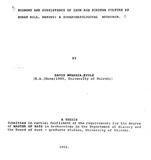| dc.description.abstract | The purpose of this study is to define the subsistence
patterns associated with a Pastoral Iron Age culture referred to
as the Sirikwa. Traces of this culture are found in archaeological
sites in the central rift valley of Kenya and the region west of
the rift from Kisii District in the south to the Mt. Elgon in the
north. On the basis of radiocarbon dates, Sirikwa Culture is
presently known to span from the 12th Century A.D. to around the
18th/19th centuries A.D. Its origins can, however be stretched as
far back as the 7th Century A.D.
Apart from subsistence reconstruction, the study goes on
to establish a consensus on Sirikwa site formation processes, site
functions, settlement patterns, culture span and spatial
distr ibution, origins, development and destiny. An attempt to
standardize attributes that characterize the Sirikwa culture is
also made. This is based on the archaeological record.
Systematic excavations were undertaken in one of the
Sirikwa sites at Hyrax Hill, Nakuru. These were in two field
sessions dur ing the second half of 1990. In total, six pits of
various dimensions and covering 70 square metres were dug to an
average depth of 1.5 metres. The excavated portion represents about
five percent of the whole site area. The excavations recovered
archaeological materials in the form of artifacts, flora and fauna.
These include pot shards, stone implements, stone vessel fragments,
pollen grains, carbonized plant nuts and animal bones. All
specimens are presently deposited at the Kenya National Museums,
Archaeology Division, accession number KNM 3982. Cultural remains
in the form of features (structural remains and hearths) were also
revealed.
This study is problem oriented and emphasis is placed on the
analysis of the faunal remains. In order to address all the
objectives, data had to be contrasted and compared and therefore
supplemented in various ways by information from past Sirikwa site
excavations at Hyrax Hill itself and elsewhere. The research shows
that pastoralism was the mainstay of the Sirikwa economy. The
evidence indicates that the people maintained domestic livestock
primarily for herd growth and secondarily for food. Cattle, sheep,
goats, donkeys and dogs were kept. Hunting and/or scavenging of
wild animal products was practised at a minimal scale, while wild
nuts, seeds, etc. may have been utilized. The Sirikwa people had
access to iron technology, and iron implements were utilized
especially in the slaughtering, butchering and disarticulation of
animal carcasses. Large cattle ribs were used for scrapping gritty
surfaces, probably hut roofs and walls. They also made use of
pottery cooking vessels.
It is felt that further research on Sirikwa is necessary
to unfold all the cultural aspects. Detailed analysis on recovered
stone implements, pottery shards and plant remains from Hyrax Hill
are yet to be finalized. It is hoped that the data will contribute
to the understand ing of the Sir ikwa. The thesis is
comprised of eight chapters, with Chapter One introducing the
project. Chapter Two presents a review of Sirikwa research prior to
the year 1990, identifies research gaps and sets up working
hypotheses. An introduction of the research area, Hyrax Hill, is
also presented. Chapter Three reports the 1990 excavations, while
Chapter Four reviews the technical aspects that constitute the
analysis of archaeological faunal remains. Both Chapter Five and
six presents the faunal data. Attributes considered include element
and taxon representation, sex, age and size structures, bone
weathering, bone fragmentation, cultural and animal bone
modifications. These attributes are discussed and interpreted in
Chapter Seven. Ethnoarchaeological models for inference are derived
from modern East African pastoralist communities. Chapter Eight
offers the research summary and conclusions and perspectives for
further research. | en |

